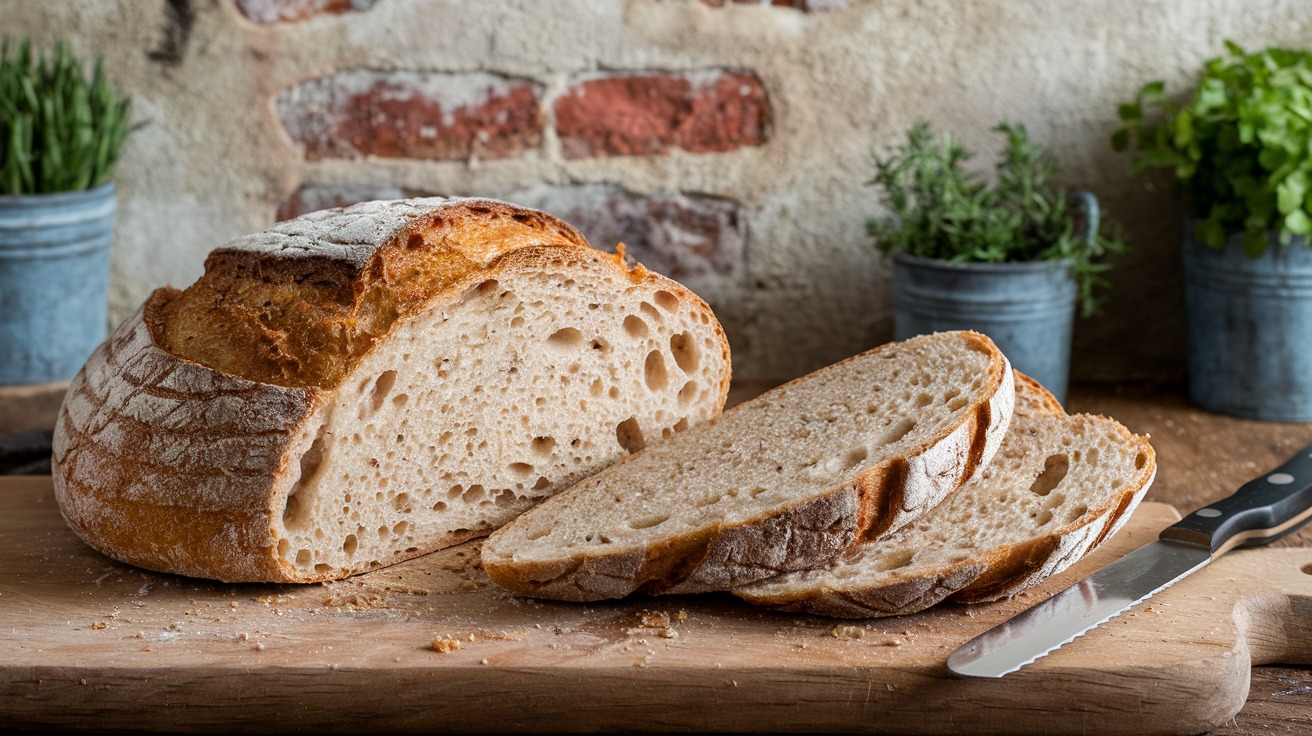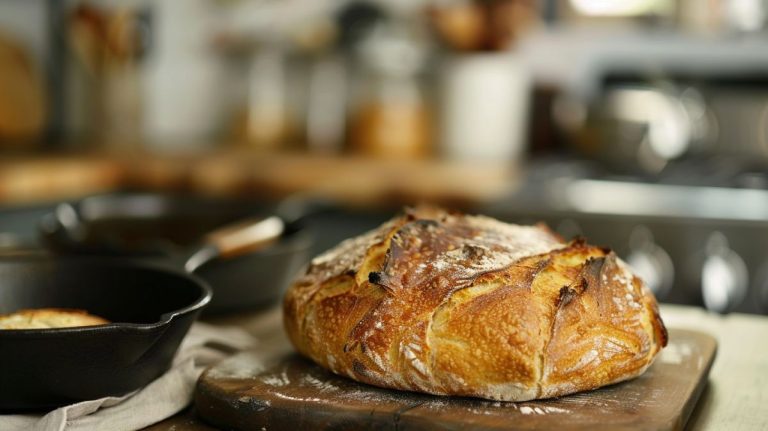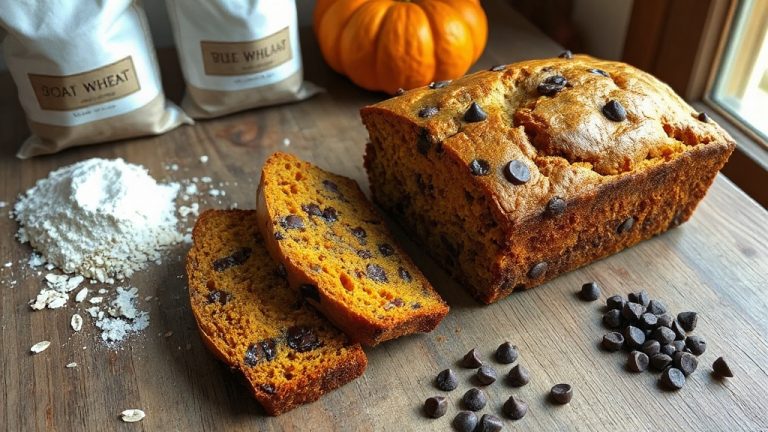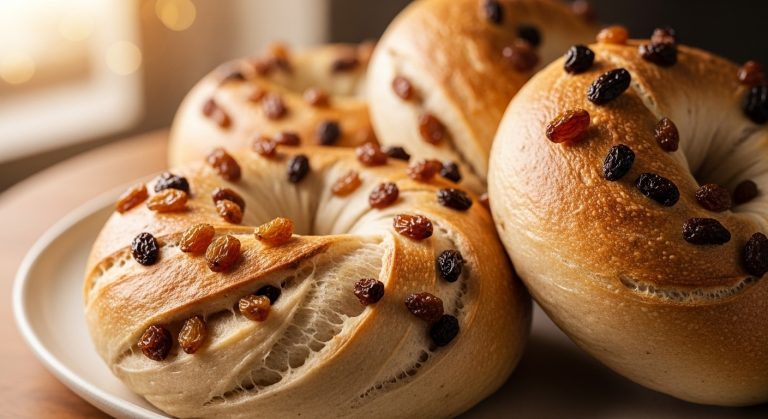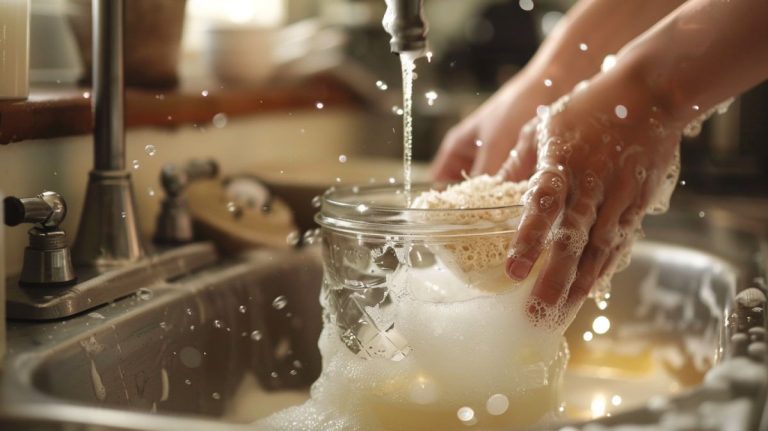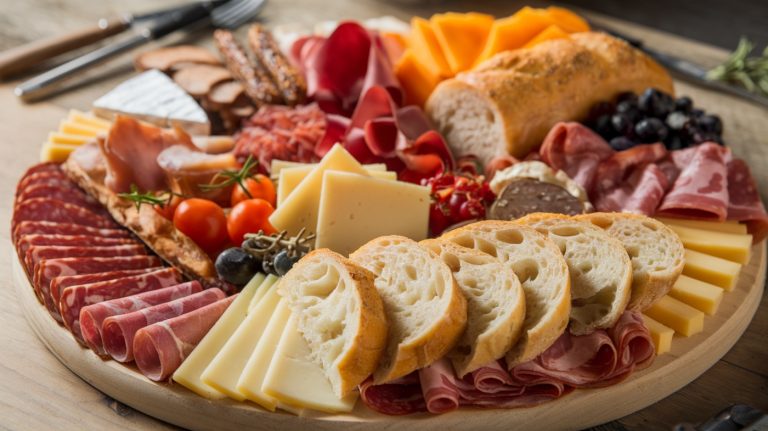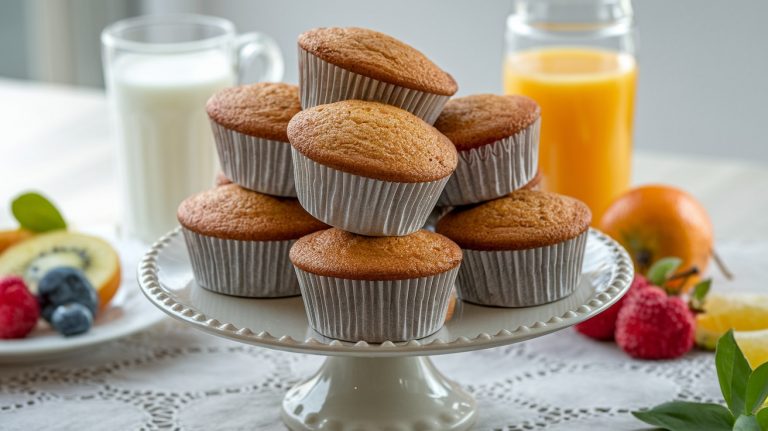What Is Levain Bread: Natural Leavening Art
Levain bread is a delightful artisan loaf that uses a natural leavening agent made from a fermented blend of flour and water, often called levain or sourdough starter. This unique process gives the bread its distinct flavor and texture.
As the levain ferments, it creates a rich aroma and a strong dough structure, contributing to a deliciously tangy taste. The key ingredients include flour, water, and salt, and maintaining an active starter is essential for great results.
Intrigued by how to make your own or the various types you can try? There’s much more to explore.
Key Takeaways
- Levain bread is made using levain, a pre-ferment of flour and water, often known as a sourdough starter, which enhances flavor and texture.
- The fermentation process involves natural yeast and bacteria, producing carbon dioxide and lactic acid, contributing to the bread’s unique aroma and taste.
- Levain typically consists of 20-40% of the total flour weight, aiding in the bread’s rise and extending its shelf life.
- Different types of levain, such as stiff, liquid, and rye levain, provide various textures and flavors, allowing for diverse baking experiences.
- Levain bread is linked to improved digestibility and nutrition, making it a healthier option compared to conventional bread.
Definition of Levain Bread
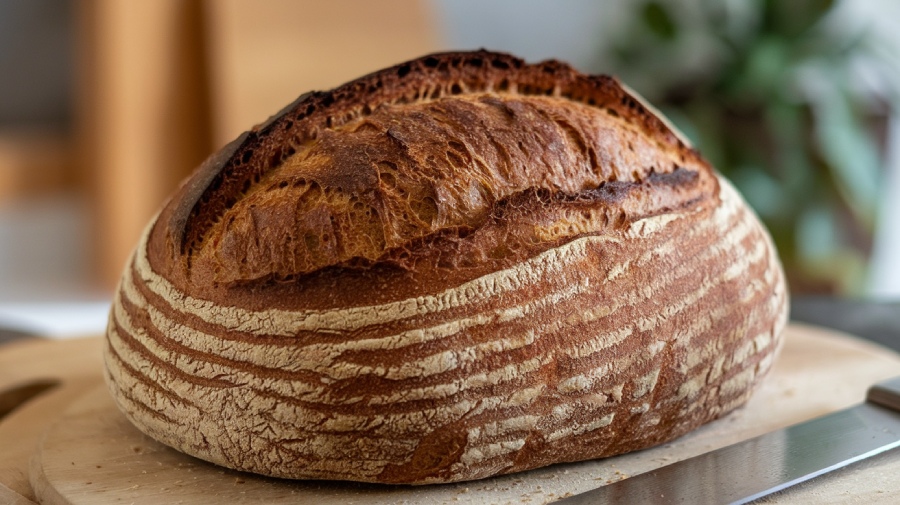
Levain bread is a unique type of bread made using levain, a pre-ferment that combines flour and water and ferments with natural yeast and microorganisms. This mixture, often referred to as a sourdough starter, is essential for imparting the bread with its distinctive taste, flavor, and texture.
In the United States, people often interchange “sourdough” and “levain,” but in Europe, these terms have specific meanings. One of the standout characteristics of levain bread is its rich aroma and flavor, resulting from the fermentation process. The strong dough structure benefits from a reduction in pH and the generation of acids, which also helps extend the bread’s shelf life without the need for preservatives. The origins of levain likely trace back to the Fertile Crescent, primarily Egypt, where bakers developed unique starters for their bread. Sourdough fermentation allows for the development of complex flavors and textures that distinguish levain from other bread types.
Depending on your baking goals, you can develop levain in various forms—stiff, liquid, or rye—determining how it interacts with your chosen flour. When you prepare levain, you’ll find that its versatility allows you to create specialty breads that showcase unique qualities.
How Levain Ferments?
It all starts when you mix flour and water, activating amylase enzymes that break down starch into maltose and glucose. This glucose becomes food for the yeast, sparking its activity and producing carbon dioxide that makes your levain rise.
As fermentation progresses, lactobacilli step in, generating lactic acid that imparts that signature tangy flavor. You’re not just creating a mixture; you’re capturing natural yeast and beneficial bacteria from your surroundings, which enrich the fermentation process. Typically, this transformation can take anywhere from 24 hours to several days, influenced by key factors like temperature, flour type, and regular feeding schedules. A strong mother starter is essential for making sure that the levain ferments effectively. Additionally, the choice of flour type can significantly impact the fermentation and flavor of your levain.
You’ll know your levain is fermenting properly by observing large bubbles forming under the surface, a fluffy texture, and nearly doubling in size. The aroma should be pleasantly sour, signaling that the fermentation is on track.
Key Ingredients for Levain
What makes the perfect levain? It’s all about the balance of key ingredients that work together to create that unique flavor and texture you crave in your bread. Here’s a quick look at the essential components you’ll need:
| Ingredient | Amount | Purpose |
|---|---|---|
| Water | 200 g | Hydrates flour, activates enzymes |
| Mature, Active Levain | 50 g | Introduces wild yeast and bacteria |
| All-Purpose Flour | 200 g | Forms the main structure |
| Whole Wheat Flour | 50 g | Enhances flavor and nutrition |
| Sea Salt | 22 g | Balances flavors and strengthens gluten |
Each of these ingredients plays a crucial role in the fermentation process, helping you achieve that crusty exterior and airy crumb. The mixture of flours allows for flexibility, letting you experiment with different textures and flavors.
Additionally, a gluten-free sourdough starter can be utilized for those seeking an alternative to traditional levain. So, as you prepare your levain, remember that every component counts, shaping the bread that will soon fill your kitchen with delightful aromas.
Steps to Build Levain
To build your levain, start with the initial mixing process, where you combine a portion of your sourdough starter with flour and water. Pay close attention to the fermentation timing factors, as this will influence the flavor and rise of your bread.
Additionally, ensure that you use an active and bubbly starter to achieve the best results. A well-maintained starter can develop complex flavors that enhance your levain and ultimately your bread.
Initial Mixing Process
Building a levain is an essential step in crafting flavorful sourdough bread, and the initial mixing process sets the foundation for your fermentation journey. To begin, gather your ingredients: an active sourdough starter, flour, and filtered water. You’ll also need a medium-size bowl or container, a mixing tool, and a cover.
Follow these steps to create your levain:
- Add the Starter: Start with 25-50 grams of your bubbly starter in the mixing container.
- Incorporate Water: Pour in 50-75 grams of room temperature filtered water, ensuring it’s around 80°F (27°C).
- Mix in Flour: Add 50-75 grams of flour, mixing thoroughly to eliminate any dry pockets.
Use a whisk, spatula, or your hands to break the starter into pieces and blend everything until it’s well combined. Regular feeding techniques for your starter are crucial to maintain its health and activity. A well-fed starter leads to better rise in your levain, ensuring optimal fermentation.
If you want, let the mixture rest for a few minutes before doing a final mix. This initial mixing sets the stage for a robust levain, which will be ready to ferment and double in size, signaling it’s primed for your sourdough bread.
Fermentation Timing Factors
Fermentation timing is essential for achieving the perfect levain, as several factors can influence how quickly it matures. One major factor is temperature. Warmer temperatures speed up the fermentation process, while cooler temperatures can slow it down considerably.
Just a few degrees can alter timing drastically—at 82°F, your levain could be mature in just four hours with a 1:1:1 ratio. Additionally, ideal fermentation temperature is crucial for achieving faster results. Maintaining the optimal fridge temperature can also help in the long-term storage of your starter, ensuring it stays healthy for levain preparation.
Another consideration is your starter’s unique characteristics. Each sourdough starter behaves differently, and your experience with it will help you gauge the right timing. Remember, recipe timings are merely guidelines. Some breads benefit from a younger levain that’s ready sooner, so getting to know your starter is key.
Hydration levels also play an important role. High hydration can dilute acids, impacting yeast and lactic acid bacteria growth rates. A liquid levain creates a more acidic environment, while a stiffer one results in less acidity.
Monitoring Levain Development
Monitoring levain development is essential for ensuring your sourdough bakes rise beautifully. By keeping a close eye on your levain, you can pinpoint the perfect moment to incorporate it into your dough.
Here are three key steps to help you effectively monitor its progress:
- Observe the Appearance: Look for bubbles and a rounded top. A well-developed levain should double in size, indicating active fermentation. This is similar to observing the bubbles and rising in a healthy sourdough starter.
- Sniff for Aroma: Take a moment to smell your levain; it should have a pleasant sour scent with hints of sweetness. If it smells overly sour or vinegary, it may be overripe.
- Check the Timing: Aim for a levain that’s just reached its peak and is starting to collapse. This is typically when it has doubled and is about to fall back on itself.
Remember to keep track of the time and temperature during fermentation, and don’t forget to label your container for easy monitoring.
A loose lid is key to allowing CO2 to escape while preventing pressure buildup.
Advantages of Using Levain
Using levain in your bread-making process offers a range of advantages that elevate both the quality and flavor of your loaves. By utilizing levain, you gain control over fermentation rates, enhance nutritional value, and embrace efficiency in your baking.
- Control Over Fermentation: You can adjust feeding ratios to manage rise times, making it easy to align with your baking schedule. Whether you’re aiming for a quick 4-hour rise or a leisurely 10-hour one, levain allows for flexibility. This adaptability is particularly beneficial as it helps maintain a regular feeding schedule for your sourdough starter’s health. Additionally, understanding the difference between starter and discard can further enhance your fermentation techniques.
- Enhanced Flavor and Nutrition: The fermentation process enriches your bread with improved digestibility and increased nutrient availability. Different flours add unique flavor profiles while retaining health benefits. Moreover, the acidity in sourdough discard can help yield tender baked goods, contributing to the overall quality of your loaves.
- Waste Reduction: With levain, you use 100% of your starter, minimizing waste. This sustainable practice not only conserves resources but also leads to precise ingredient usage, ensuring that you make the most of your baking efforts.
Incorporating levain into your routine not only improves the quality of your bread but also supports a more sustainable and health-conscious approach to baking.
Common Types of Levain
When exploring common types of levain, you’ll discover unique characteristics that can transform your baking. Stiff levain offers a robust structure, while liquid levain contributes a more open crumb, and rye levain enhances flavor with its earthy notes. Each type brings its own benefits, allowing you to experiment and elevate your bread-making skills.
Stiff Levain Characteristics
Characterized by its firm texture and lower hydration, stiff levain plays an essential role in many bread recipes. With a hydration level of 50%-65%, this thick mixture adds unique properties to your dough. You’ll typically use about half the amount of water as flour, resulting in a dough ball that requires kneading until smooth.
Here are some key characteristics of stiff levain:
- Elasticity and Strength: It enhances the elasticity of the dough while tempering the acidity in sourdough, making it perfect for enriched doughs like sourdough babka and bagels.
- Versatility: Stiff levain stays at its peak longer than liquid levain, allowing for a slightly longer bulk fermentation time and making it suitable for recipes where a sour flavor isn’t desired, like cinnamon rolls.
- Ripe Indicators: You know your levain is ready when it doubles in size, has a rounded top, and shows bubbles. Overripe levain, however, can produce unpleasant odors and should be restarted.
Using stiff levain can elevate your baking, providing structure and flavor control in your breads.
Liquid Levain Uses
Liquid levain serves as a powerhouse in the world of bread making, bringing a unique combination of flavor and texture to your baked goods. With hydration levels often exceeding 100%, this type of levain allows for a lighter, airier crumb in your loaves. When you use liquid levain, you’re not just leavening your bread; you’re infusing it with complex flavors from wild yeasts and lactic bacteria.
You’ll find liquid levain particularly versatile, as you can adjust its hydration to suit different recipes. Typically used at ratios of 15% to 25% of the total flour weight, it’s key to check that it’s vigorously expanded and bubbly before mixing it into your dough. This guarantees you’re capturing the full potential of its fermentation power. Additionally, the ideal temperature for fermentation is around 75°F (24°C), which aids in maximizing yeast activity.
As you prepare your liquid levain, start with a small amount of sourdough starter, mixing it with flour and water. After regular feedings and a period of maturation, it’ll be ready to elevate your baking experience. Regular observation and care are essential to keep your levain thriving and improving over time.
Expect a pancake batter-like consistency that transforms into a bubbly, ripe mixture, perfect for creating deliciously tangy sourdough breads that impress every time.
Rye Levain Benefits
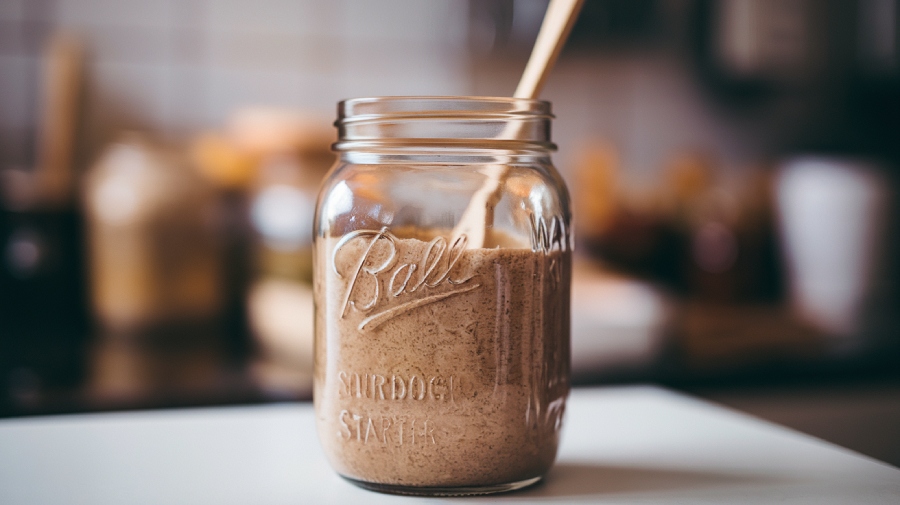
Although many bakers are familiar with traditional wheat levains, rye levain offers a wealth of benefits that make it a standout choice for your bread-making adventures. When you choose rye, you’re not just opting for a unique flavor; you’re also gaining several health advantages.
1. High Fiber Content: Rye bread is packed with fiber, which aids digestion and helps regulate blood sugar levels. This means you’ll feel fuller for longer, making it easier to manage your weight.
2. Digestive Health: The fermentation process in rye levain breaks down gluten’s indigestible proteins, making it easier on the stomach for those with gluten sensitivity.
Plus, it can effectively treat constipation.
3. Nutritional Benefits: Rye bread boasts higher levels of essential nutrients like zinc, magnesium, and calcium compared to wheat bread.
Research even links rye consumption to a lower risk of certain cancers.
Frequently Asked Questions
Can I Use Store-Bought Yeast Instead of a Sourdough Starter?
Yes, you can use store-bought yeast instead of a sourdough starter!
It’ll give your bread a reliable rise and a quicker fermentation process. However, you might miss out on the complex flavors that a sourdough starter develops over time.
If you’re looking for convenience, store-bought yeast is great, but for a unique taste and texture, consider trying sourdough in the future.
Each method has its own charm!
How Long Does It Take to Prepare Levain Before Baking?
Preparing levain is like nurturing a seed; it requires patience and the right conditions to blossom.
Typically, it takes anywhere from 3 to 12 hours to prepare levain, depending on factors like temperature and starter strength.
You’ll know it’s ready when it doubles in volume, signaling it’s active and ripe for your dough.
Keep an eye on it, and adjust your methods for quicker fermentation if needed.
Happy baking!
What Type of Flour Is Best for Creating Levain?
When you’re creating levain, the type of flour you choose can really impact your bread. All-purpose flour offers versatility, while whole wheat brings an earthy depth.
If you want a robust flavor, rye flour’s your best bet. Mixing flours can also reveal unique flavors and textures, allowing you to experiment.
Can I Refrigerate Levain to Slow Down Fermentation?
Yes, you can refrigerate levain to slow down fermentation.
Refrigerating helps you pause the process, manage your baking schedule, and maintain levain’s health.
Just remember to let it come to room temperature before mixing, or use warm water to assist.
Regular feeding is essential, too, keeping your levain active and ready for future use.
How Do I Know if My Levain Is Ready to Use?
You’ll know your levain is ready to use when it floats in water, indicating good fermentation.
Look for it to double in volume, with bubbles throughout and on the surface. A consistent rise and fall pattern helps you plan your baking.
Typically, this process takes 8-12 hours, influenced by temperature and starter maturity.
Keep an eye on these indicators, and you’ll achieve a perfect levain for your baking adventures!
Levain Bread: Where Flavor Meets Tradition
In the world of baking, levain bread stands out for its unique flavor and texture, a delightful coincidence of time and fermentation. As you embrace the art of building your own levain, you’ll discover not just a technique, but a connection to ancient traditions.
The simplicity of ingredients transforms into something extraordinary, proving that the magic lies in patience and care. So, roll up your sleeves, and let your levain journey begin—your taste buds will thank you.

